How Student Researchers Can Change the World
Student scientists’ experiences at Montclair State shape their goals for the future
Posted in: Homepage News, Research, Science and Technology, University
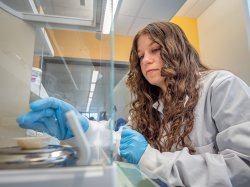
Ask Earth and Environmental Science major Samantha Benjamin about global warming and she’s likely to take you back to the Paleocene-Eocene era and the rapid global warming event that took place 56 million years ago.
Benjamin, now a senior, knows so much about the Paleocene-Eocene Thermal Maximum (also known as PETM) because, like a lot of undergraduates in the College of Science and Mathematics, she has had the opportunity to conduct research with a faculty researcher on topics that interest them.
And that research has paid off.
Benjamin won first place at the 2021 Mario M. Casabona Future Scientists Awards competition in November for her research on PETM.
As part of the Future Scientists program, Benjamin, along with five other student researchers, presented their research in both a poster session and in five-minute oral presentations at the Awards held at the Center for Environmental and Life Sciences in November. The program trains student researchers to communicate their scientific research to the general public, helping them to succeed in their graduate education and career paths. The program’s sponsor, Mario M. Casabona, an entrepreneur and founder and managing director of TechLaunch LLC and Casabona Ventures, attended and was joined by a professional panel of judges, who determined the winner.
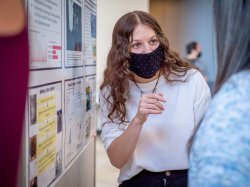
Students presented research on topics varying from mathematical education to neutron star structure in gravitational waves to a protein’s relationship to melanoma to how treatment for inflammation can be derived from mathematical models, and much more.
Undergraduate, as well as graduate, research is a hallmark of the College of Science and Mathematics, says Dean Lora Billings.
“Faculty-mentored student research is really important because not only does it allow the student the freedom to explore and be creative, but to also be a problem solver with confidence to think out of the box,” Billings says. “This falls under the world of experiential learning, where a student uniquely applies what they have learned in the classroom and then sharpens their communication skills by telling the story.”
Studying and researching with professors is an important step for many future scientists. Before receiving the research opportunity with Earth and Environmental Studies Assistant Professor Ying Cui, Benjamin says she felt unqualified for research.
“I was initially very intimidated because I thought, ‘Here I am, an undergraduate, with no resume qualified experience and definitely not specializing in a singular topic,’ ” Benjamin says.
However, Cui made it clear that she was very open to having students of all levels get involved, and Benjamin’s experience has been meaningful ever since.
“This experience will be one I will carry with me in my future,” Benjamin says. “Dr. Cui is an incredible mentor and my involvement has given me the chance to understand more deeply the time, effort, money and methods that go along with true research.”
Winning first place after presenting her research on how black carbon is used as a tool to understand how ecosystems responded to the PETM global warming event was a tremendous feeling, she says. Her research gave her the preparation she needed to confidently discuss how society is dependent on the ecosystem and therefore it is essential to understand how it will respond to climate change.
As part of her research, Benjamin has had the access to work with high-grade equipment alongside fellow student researchers like Melissa Spigelman, a junior studying Molecular Biology, who has also gotten a meaningful experience out of her research.
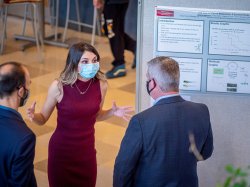
Spigelman was awarded second place and audience favorite for her research on a protein known as ICER and its relationship to melanoma – the deadliest form of skin cancer. Her goal is to create a cream that contains ICER and protein that could kill off the melanoma and prevent those cancer cells from spreading.
Her interest in research was inspired by her best friend who suffered from Hodgkin’s Lymphoma, a cancer in the lymph nodes. While Spigelman always had a hidden passion for biology, watching her friend fight cancer only further inspired her to make a change in the world.
“I wanted to help in any possible way that I can,” Spigelman says.
During the time her friend was undergoing cancer treatment, Speigelman was offered a remarkable opportunity at Montclair State through one of her close friends, Angelo Cirinielli. At the time, Cirinelli was a senior researcher at the University while she was only a senior in high school. After speaking with Biology Professor Carlos Molina, Cirinelli was able to bring Speigelman on board. The two have worked together on research projects ever since.
“It was honestly a true blessing that Dr. Molina was willing to take a chance on me at such a young age,” Speigelman says. “I’m just so glad that one day in the future, I feel like we’ll be able to find a treatment for really aggressive cancers like melanoma.”
The student research opportunities offered at Montclair State took Cirinelli to the next level of his career in molecular biology. After winning a first-place award for melanoma cancer research in the Future Scientists Awards of 2019, he is now studying at Rutgers in the Biomedical PhD program.
“It’s been very meaningful to work with Dr. Molina on research as an undergrad and now as a PhD candidate,” Cirinelli says. “At the event, it was great to see that other people also understood the importance of the projects that we have going on in the lab.”
When Cirinelli was a freshman, he knew he wanted to get into research but wasn’t sure how to get involved. Dr. Molina’s research caught his eye one semester so he decided to simply ask him if he needed some assistance.
“A lot of people don’t know how to go to the professors during their office hours and just ask. The worst thing that they could say is that their lab is full,” Cirinelli says.
Once involved in the research, the students typically spend on average 16 to 18 hours of research per week while the projects take at least one or two years to complete before being presented at the annual Mario M. Casabona Future Scientists Awards competition.
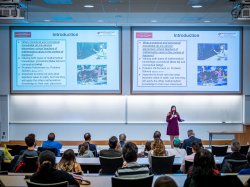
Gianna Fazzini, a senior from West Caldwell, New Jersey, was the first mathematics education student to present at the Future Scientists event. Through her research in the realm of math education, she hoped to open people’s eyes up to the world of math education, and in what direction it’s heading.
Her passion drew her toward math education research since the subject was never her strong suit. She believes that math education focuses mostly on procedures rather than on concepts and she seeks to change that with a balance of both in the classroom.
“I believe as future research goes, it’s important to study teachers in their own classroom settings in order to make the connection between the tools that teachers are providing their students, and the tools that they were provided in their teacher preparation program,” Fazzini says.
Through her research with Assistant Mathematics Professor Joseph DiNapoli, Fazzini urges students to get involved in research and spark new changes around the world.
“Being able to research something that was so meaningful to the both of us made this an enjoyable experience and I strongly urge anybody who has the chance to do research on campus to take advantage of it because it gives you the ability to view the world in a different light,” Fazzini says.
The student researchers are taking a positive approach to research, science and math in hopes of encouraging others to follow their examples and to make a decision to embark on something that didn’t seem possible.
For more information, visit the 2021 Mario M. Casabona Future Scientists Awards webpage.
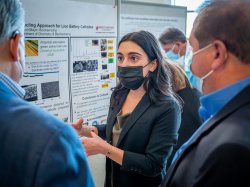
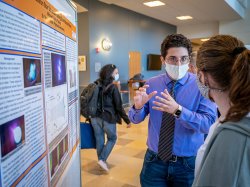
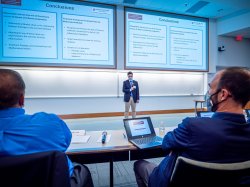
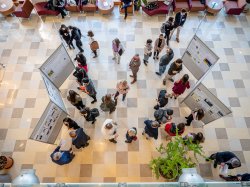
Story by Rosaria Lo Presti; photos by University Photographer Mike Peters
